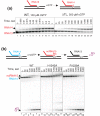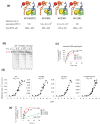Stepwise mechanism for transcription fidelity
- PMID: 20459653
- PMCID: PMC2874521
- DOI: 10.1186/1741-7007-8-54
Stepwise mechanism for transcription fidelity
Abstract
Background: Transcription is the first step of gene expression and is characterized by a high fidelity of RNA synthesis. During transcription, the RNA polymerase active centre discriminates against not just non-complementary ribo NTP substrates but also against complementary 2'- and 3'-deoxy NTPs. A flexible domain of the RNA polymerase active centre, the Trigger Loop, was shown to play an important role in this process, but the mechanisms of this participation remained elusive.
Results: Here we show that transcription fidelity is achieved through a multi-step process. The initial binding in the active centre is the major discrimination step for some non-complementary substrates, although for the rest of misincorporation events discrimination at this step is very poor. During the second step, non-complementary and 2'-deoxy NTPs are discriminated against based on differences in reaction transition state stabilization and partly in general base catalysis, for correct versus non-correct substrates. This step is determined by two residues of the Trigger Loop that participate in catalysis. In the following step, non-complementary and 2'-deoxy NTPs are actively removed from the active centre through a rearrangement of the Trigger Loop. The only step of discrimination against 3'-deoxy substrates, distinct from the ones above, is based on failure to orient the Trigger Loop catalytic residues in the absence of 3'OH.
Conclusions: We demonstrate that fidelity of transcription by multi-subunit RNA polymerases is achieved through a stepwise process. We show that individual steps contribute differently to discrimination against various erroneous substrates. We define the mechanisms and contributions of each of these steps to the overall fidelity of transcription.
Figures





Similar articles
-
Five checkpoints maintaining the fidelity of transcription by RNA polymerases in structural and energetic details.Nucleic Acids Res. 2015 Jan;43(2):1133-46. doi: 10.1093/nar/gku1370. Epub 2014 Dec 30. Nucleic Acids Res. 2015. PMID: 25550432 Free PMC article.
-
Kinetics of nucleotide entry into RNA polymerase active site provides mechanism for efficiency and fidelity.Biochim Biophys Acta Gene Regul Mech. 2017 Apr;1860(4):482-490. doi: 10.1016/j.bbagrm.2017.02.008. Epub 2017 Feb 24. Biochim Biophys Acta Gene Regul Mech. 2017. PMID: 28242207 Free PMC article.
-
T7 RNA Polymerase Discriminates Correct and Incorrect Nucleoside Triphosphates by Free Energy.Biophys J. 2018 Apr 24;114(8):1755-1761. doi: 10.1016/j.bpj.2018.02.033. Biophys J. 2018. PMID: 29694856 Free PMC article.
-
Transcription fidelity and its roles in the cell.Curr Opin Microbiol. 2018 Apr;42:13-18. doi: 10.1016/j.mib.2017.08.004. Epub 2017 Sep 29. Curr Opin Microbiol. 2018. PMID: 28968546 Free PMC article. Review.
-
The Mechanisms of Substrate Selection, Catalysis, and Translocation by the Elongating RNA Polymerase.J Mol Biol. 2019 Sep 20;431(20):3975-4006. doi: 10.1016/j.jmb.2019.05.042. Epub 2019 May 31. J Mol Biol. 2019. PMID: 31153902 Free PMC article. Review.
Cited by
-
Structure and function of the Si3 insertion integrated into the trigger loop/helix of cyanobacterial RNA polymerase.bioRxiv [Preprint]. 2024 Jan 11:2024.01.11.575193. doi: 10.1101/2024.01.11.575193. bioRxiv. 2024. Update in: Proc Natl Acad Sci U S A. 2024 Feb 20;121(8):e2311480121. doi: 10.1073/pnas.2311480121. PMID: 38260627 Free PMC article. Updated. Preprint.
-
Trigger-helix folding pathway and SI3 mediate catalysis and hairpin-stabilized pausing by Escherichia coli RNA polymerase.Nucleic Acids Res. 2014 Nov 10;42(20):12707-21. doi: 10.1093/nar/gku997. Epub 2014 Oct 21. Nucleic Acids Res. 2014. PMID: 25336618 Free PMC article.
-
RNA polymerase II transcriptional fidelity control and its functional interplay with DNA modifications.Crit Rev Biochem Mol Biol. 2015;50(6):503-19. doi: 10.3109/10409238.2015.1087960. Epub 2015 Sep 22. Crit Rev Biochem Mol Biol. 2015. PMID: 26392149 Free PMC article. Review.
-
Allosteric Effector ppGpp Potentiates the Inhibition of Transcript Initiation by DksA.Mol Cell. 2018 Mar 1;69(5):828-839.e5. doi: 10.1016/j.molcel.2018.01.035. Epub 2018 Feb 22. Mol Cell. 2018. PMID: 29478808 Free PMC article.
-
Widespread epistasis shapes RNA Polymerase II active site function and evolution.bioRxiv [Preprint]. 2025 Jun 27:2023.02.27.530048. doi: 10.1101/2023.02.27.530048. bioRxiv. 2025. PMID: 36909581 Free PMC article. Preprint.
References
-
- Sosunov V, Zorov S, Sosunova E, Nikolaev A, Zakeyeva I, Bass I, Goldfarb A, Nikiforov V, Severinov K, Mustaev A. The involvement of the aspartate triad of the active center in all catalytic activities of multisubunit RNA polymerase. Nucleic Acids Res. 2005;33:4202–4211. doi: 10.1093/nar/gki688. - DOI - PMC - PubMed
Publication types
MeSH terms
Substances
Grants and funding
- 202994/ERC_/European Research Council/International
- GM64530/GM/NIGMS NIH HHS/United States
- BB/I004564/1/BB_/Biotechnology and Biological Sciences Research Council/United Kingdom
- BB/F013558/1/BB_/Biotechnology and Biological Sciences Research Council/United Kingdom
- BB/F006462/1/BB_/Biotechnology and Biological Sciences Research Council/United Kingdom
LinkOut - more resources
Full Text Sources

